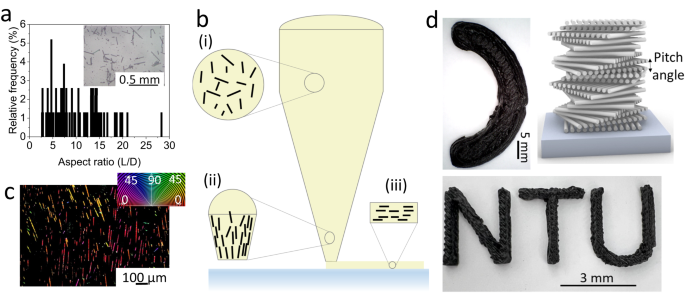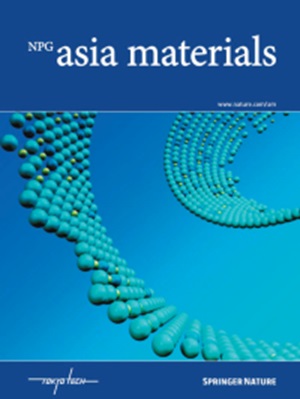3D打印Bouligand结构不连续纤维复合材料的抗冲击性能
IF 8.3
2区 材料科学
Q1 MATERIALS SCIENCE, MULTIDISCIPLINARY
引用次数: 0
摘要
在螳螂虾的dactyl俱乐部中发现的Bouligand结构以其抗冲击性而闻名。然而,bouligand启发的具有三维形状和抗冲击特性的增强复合材料尚未得到证实。本文采用直接墨水书写的方法,3D打印由玻璃微纤维增强的复合材料,将其组装成具有可控俯仰角的布利甘结构。结果表明,Bouligand复合材料在冲击作用下的能量吸收水平高于单向超细纤维定向复合材料。此外,当俯仰角为40°时,Bouligand复合材料的最大能量吸收为2.4 kJ/m2,比单向复合材料高140%。此外,通过对裂缝表面形貌的表征和数值模拟,揭示了裂缝扭转和裂缝桥接机制的结合。当俯仰角为40°时,复合材料的抗弯强度为36.9 MPa,刚度为2.26 GPa,吸能为8 kJ/m2,抗弯性能最强。这些发现对于在航空航天、交通运输和国防领域使用直接墨水书写的工程复合材料的微结构设计具有很大的前景。本文章由计算机程序翻译,如有差异,请以英文原文为准。


Izod impact resistance of 3D printed discontinuous fibrous composites with Bouligand structure
The Bouligand structure found in the dactyl club of mantis shrimps is known for its impact resistance. However, Bouligand-inspired reinforced composites with 3D shapes and impact resistance characteristics have not yet been demonstrated. Herein, direct ink writing was used to 3D print composites reinforced with glass microfibers assembled into Bouligand structures with controllable pitch angles. The energy absorption levels of the Bouligand composites under impact were found to surpass those of composites with unidirectional microfiber alignment. Additionally, the Bouligand composites with a pitch angle of 40° exhibited a maximum energy absorption of 2.4 kJ/m2, which was 140% higher than that of the unidirectional composites. Furthermore, the characterization of the topography of the fractured surface, supplemented with numerical simulations, revealed a combination of crack twisting and crack bridging mechanisms. Flexural tests conducted on the composites with a pitch angle of 40° revealed that these composites had the strongest properties, including a flexural strength of 36.9 MPa, a stiffness of 2.26 GPa, and energy absorption of 8 kJ/m2. These findings are promising for the microstructural design of engineered composites using direct ink writing for applications in aerospace, transportation, and defense. Inspired by Bouligand structure in the dactyl club of the mantis shrimp, direct ink writing is used to 3D print Bouligand composites reinforced with glass microfibres at controllable pitch angles. The Bouligand composites with a pitch angle of 40˚ exhibited a maximum energy absorption of 2.4 kJ/m2, which was 140 % higher than the unidirectional composites. The topography of the fractured surface supplemented with numerical simulations revealed the combination of crack twisting and crack bridging mechanisms. These findings have implications for the microstructural design of engineered composites using direct ink writing for applications in aerospace, transportation, defense, etc.
求助全文
通过发布文献求助,成功后即可免费获取论文全文。
去求助
来源期刊

Npg Asia Materials
MATERIALS SCIENCE, MULTIDISCIPLINARY-
CiteScore
15.40
自引率
1.00%
发文量
87
审稿时长
2 months
期刊介绍:
NPG Asia Materials is an open access, international journal that publishes peer-reviewed review and primary research articles in the field of materials sciences. The journal has a global outlook and reach, with a base in the Asia-Pacific region to reflect the significant and growing output of materials research from this area. The target audience for NPG Asia Materials is scientists and researchers involved in materials research, covering a wide range of disciplines including physical and chemical sciences, biotechnology, and nanotechnology. The journal particularly welcomes high-quality articles from rapidly advancing areas that bridge the gap between materials science and engineering, as well as the classical disciplines of physics, chemistry, and biology. NPG Asia Materials is abstracted/indexed in Journal Citation Reports/Science Edition Web of Knowledge, Google Scholar, Chemical Abstract Services, Scopus, Ulrichsweb (ProQuest), and Scirus.
 求助内容:
求助内容: 应助结果提醒方式:
应助结果提醒方式:


